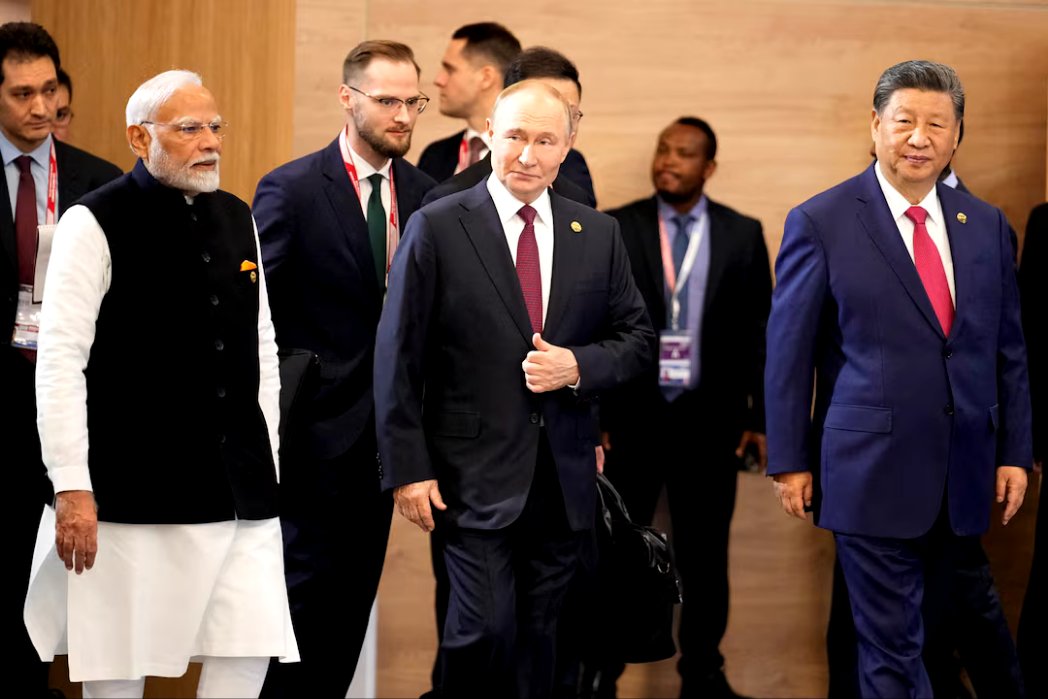EXPLAINED: Modi, Xi and Putin Signal Multipolar Future at SCO Summit as U.S. Tariffs End American Dominance
Indian Prime Minister Narendra Modi’s meeting with Chinese President Xi Jinping on Sunday has signalled a major recalibration in Asia’s power dynamics. Held on the sidelines of the Shanghai Cooperation Organisation (SCO) Summit in Tianjin, it comes as Modi prepares for a crucial engagement with Russian President Vladimir Putin — putting India at the centre of a Global South realignment that openly challenges U.S. tariff pressure and unilateral trade coercion.
 |
| Image Source: MeghUpdates |
India's National Security Adviser Ajit Doval’s quiet talks with President Putin in early August reinforced that trajectory. Bilateral trade has surged fivefold to $68 billion, but India is pushing to correct a $58.9 billion deficit and expand exports in agriculture, pharmaceuticals, and textiles. Full story here.
Chinese President Xi Jinping told Indian Prime Minister Modi that China and India are cooperation partners, not rivals, and that the two countries are each other's development opportunities rather than threats.
— Xu Feihong (@China_Amb_India) August 31, 2025
As long as the two countries stick to this overarching direction,… pic.twitter.com/QY8d8KczQR
For both Moscow and New Delhi, the tariff standoff with Washington has accelerated alignment within the BRICS bloc. Brazil, Russia, India, China, and South Africa — joined by Iran, Egypt, and others -- are increasingly presenting themselves as the nucleus of a multipolar order that resists unilateral sanctions.
As Prime Minister Modi has argued repeatedly, “strategic autonomy” and “economic sovereignty” are no longer slogans but necessities. More on India’s defence of Russian oil imports here.
Chinese President Xi Jinping struck an unmistakable note of multipolar ambition, declaring that “the dragon and the elephant must come together.” Stressing that China and India are the world’s most civilizational and populous countries, he said the two must act as “good neighbours” and work jointly for peace and prosperity in Asia and beyond.
He underlined that 2025 marks the 75th anniversary of diplomatic relations between the two nations, and urged a long-term strategic perspective. Xi’s remarks here.
Had a fruitful meeting with President Xi Jinping in Tianjin on the sidelines of the SCO Summit. We reviewed the positive momentum in India-China relations since our last meeting in Kazan. We agreed on the importance of maintaining peace and tranquility in border areas and… pic.twitter.com/HBYS5lhe9d
— Narendra Modi (@narendramodi) August 31, 2025
The Indian Prime Minister responded with equal emphasis on stability. He recalled last year’s meeting in Kazan that gave “positive momentum” to bilateral ties, and welcomed disengagement along the border, the reopening of the Kailash Mansarovar route, and the resumption of direct flights.
“The welfare of 2.8 billion people is closely tied to the state of India–China relations,” Modi said, reiterating India’s commitment to advancing ties based on trust, mutual respect, and sensitivity. Read Modi’s full remarks.
India's Foreign Secretary Vikram Misri confirmed that Xi put forward four suggestions: strengthening communication and deepening trust, expanding cooperation, accommodating concerns, and reinforcing multilateral coordination.
All were received positively by the Indian side, with both leaders stressing that differences must not become disputes.
🇷🇺🇨🇳 Presidents Vladimir Putin & Xi Jinping 🤝
— MFA Russia 🇷🇺 (@mfa_russia) August 31, 2025
Russia's President Vladimir Putin takes part in a welcoming ceremony held for the participants in the 2025 Shanghai Cooperation Organisation Summit in Tianjin, China.
The official events of the Summit to take place on September 1. pic.twitter.com/PjYWUK26b1
But it is the broader context that gives the Tianjin meetings their global weight. Modi’s visit is his first to China in seven years, during which ties froze after the 2020 Galwan clashes. It is also taking place as India faces 50% tariffs imposed by U.S. President Donald Trump, justified on the grounds of India’s continued import of discounted Russian crude oil.
New Delhi has dismissed the move as “unjustified and unreasonable,” while Moscow has called it “illegitimate economic coercion.”
The SCO setting underscores this trend. Beyond his talks with Xi, Modi met a wide spectrum of leaders: Kyrgyzstan’s Sadyr Japarov, Uzbekistan’s Shavkat Mirziyoyev, Kazakhstan’s Kassym-Jomart Tokayev, Vietnam’s Phạm Minh Chính, Egypt’s Mostafa Madbouly, and Belarus’s Alexander Lukashenko among others. He also engaged with Armenia, Turkmenistan, Laos, and Tajikistan, strengthening partnerships that collectively amplify Global South voices.
President of #Russia Vladimir #Putin has arrived in #China.https://t.co/prJeRklmwO pic.twitter.com/RCgi4z9rlA
— MFA Russia 🇷🇺 (@mfa_russia) August 31, 2025
Xi’s message of civilizational solidarity, Modi’s emphasis on trust and peace, and Putin’s pending discussions with the Indian leader all converge on a common theme: the erosion of U.S. dominance.
Trump’s tariff blitz has hardened perceptions across Asia and Eurasia that Washington is using trade as a weapon, even against partners. In Tianjin, Modi’s diplomacy illustrates the alternative -- diversified partnerships, multipolar cooperation, and a deliberate balance between economic pragmatism and strategic autonomy.
Modi wrote after his meeting with Xi: “We agreed on the importance of maintaining peace and tranquility in border areas and reaffirmed our commitment to cooperation based on mutual respect, mutual interest and mutual sensitivity.”
That formula now awaits its next test -- his meeting with Vladimir Putin -- which could yield concrete steps to expand rupee–ruble settlements, deepen defence cooperation, and push BRICS further into the role of a counterweight to Western economic dominance.
For the Global South, Tianjin is a visible assertion that multipolarity becoming the structure of global affairs.
🔗 Xi’s “dragon and elephant” remarks | Full Modi–Xi meeting details | Jaishankar–Lavrov Moscow talks | India defends Russian oil imports | Doval–Putin meeting | Modi–Putin call
